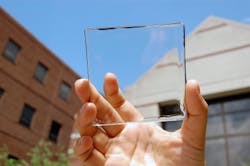Solar Concentrators: Colorless dopants make luminescent solar concentrator transparent as a window
A team of researchers at Michigan State University (East Lansing) has developed a luminescent solar concentrator that is completely transparent in the visible region, allowing windows to be used to collect solar energy with no change in appearance.1
Cell phones and other devices are also potential targets for the technology.
A luminescent solar concentrator (LSC) is a pane of doped transparent material; incoming sunlight excites the dopant, which re-emits light that is mostly conducted via total internal reflection to the edge of the pane, where photovoltaic (PV) cells convert the light to electrical power. While LSCs are not yet in wide use due to continuing experimentation with geometries, dopants, and dopant concentrations to try to bring concentration ratios up to acceptable levels, they do have potential advantages such as low cost and the ability to concentrate sunlight on cloudy days.
The dopant in conventional LSCs is tinted, often bright yellow or red, making the concentrator unsuitable for use as a window. The dopants in the new LSC only absorb light in the near-IR regions (emitting it as IR), which makes the device colorless in appearance. The dopant for the prototype is a blend of cyanine and cyanine salt that has absorption peaks at 742 and 733 nm and emission peaks at 772 and 753 nm. The researchers are interested in the use of combined UV and NIR transparent LSCs that also contain, for example, UV-harvesting hexanuclear metal halide clusters; the visible region of the spectrum is then still left untouched, ensuring a colorless LSC.
Getting the size right
One of the trickier parts of designing a LSC is getting the dimensions and dopant concentrations right; getting them wrong can mean either that too much of the re-emitted light is reabsorbed before it reaches the edges (and thus the photovoltaic cells), or that a nonoptimum (too low) proportion of the incoming sunlight is absorbed by the dopant. Based on the amount of wavelength shift between absorption and re-emission (Stokes shift), detailed calculations showed optimum LSC plate sizes ranging from 1 cm to greater than 1 m, with smaller Stokes shifts leading to smaller plate sizes.
The prototype, which has 20 and 30 nm Stokes shifts for the two dopants, is 2 × 2 × 0.1 cm in size; future dopants with Stokes shifts of around 100 nm could allow meter-sized plates; however, the Stokes-shifted wavelength is longer, and the bandgap of the PV semiconductor also has to be taken into consideration. (Plates 7 × 7 × 0.1 cm in size were also fabricated for experimental measurements of external quantum efficiency.)
The big advantage of the Michigan State University design is its lack of hue; the device looks like a piece of ordinary clear plastic. “No one wants to sit behind colored glass,” says Richard Lunt, one of the researchers. “It makes for a very colorful environment, like working in a disco.”
If the extensive windows of large buildings could be fully used to capture UV and IR solar energy without losing the appeal that normal windows have, large additional areas for capturing the sun’s energy would quickly become available without the need for taking up additional land, which is especially hard to find in cities.
“[The colorless LSC] opens a lot of area to deploy solar energy in a nonintrusive way,” Lunt says. “It can be used on tall buildings with lots of windows or any kind of mobile device that demands high aesthetic quality like a phone or e-reader. Ultimately we want to make solar harvesting surfaces that you do not even know are there.”
Lunt notes that more work is needed in order to improve the efficiency of the LSC. Currently it has a solar-conversion efficiency close to 1%; the researchers aim to produce efficiencies beyond 5%. The best colored LSC to date has an efficiency of around 7%.
REFERENCE
1. Yimu Zhao et al., Adv. Opt. Mat. (2014); doi: 10.1002/adom.201400103.
About the Author
John Wallace
Senior Technical Editor (1998-2022)
John Wallace was with Laser Focus World for nearly 25 years, retiring in late June 2022. He obtained a bachelor's degree in mechanical engineering and physics at Rutgers University and a master's in optical engineering at the University of Rochester. Before becoming an editor, John worked as an engineer at RCA, Exxon, Eastman Kodak, and GCA Corporation.

